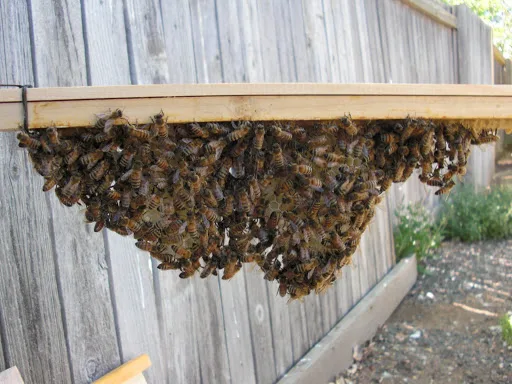 |
| A swarm in May is worth a load of hay. A swarm in June is worth a silver spoon. A swarm in July, let it fly. |
"Hey, Grampa... the nuc bees swarmed" PART 2:
... The cluster of bees hung out in the neighbor's pine tree, sending out a scout bee or three on occasion. On the afternoon that they swarmed, we saw a lone bee sniffing out the nuc box. She went in, came out and flew back to the tree. The Hardison Hive went seemingly unnoticed. Meanwhile the parent colony went about its business, but at a greatly reduced level of activity. While foragers continued to return with pollen, only a handful of bees came out for Play Time.The overnight lows have been abnormally warm, in the 50s, so the bees were safe for the night up in the tree. They'd clustered in towards the trunk, under some branches on the west side of the tree, but were still up early on the second morning. All day long, scout bees could be seen investigating the nuc box. Again the Hardison Hive went unnoticed, despite having been baited with some beautiful drawn comb. We should've baited it with dark brood combs, though, as the Hardison Hive is one we only built last Fall so it didn't have a lived-in smell to beckon the bees. The nuc box, on the other hand, had been established for over a month, Brent Edelen told me.
Brent is Grampa's grandson and the beekeeper who produced the nuc. Despite being a 6th generation beekeeper, he is perplexed as to why the nuc swarmed. We're still emailing back and forth, discussing possibilities such as the bees being honey bound versus a robbing situation, or them not liking some environmental factor such as contaminated comb in their new hive. Definitely not an issue. We postulated on whether the "GG Queen" had gotten squashed during the nuc's establishment and replacement queens had been raised. While we did see a queen cup in the nuc, there was no mature queen cell so supersedure doesn't seem to be an explanation either.
‘‘There’s only one queen, and that’s Madonna, bitch.” – lyrics from MDNA
Well, on the morning of the third day up in the pine tree, the swarm started sending out lots of scouts. The Hardison Hive again went ignored but the nuc box had a constant group of bees investigating the many holes to go in/out. There were the four holes in the floor, now four holes in the top because we'd jury-rigged the top bars in a way that the lid didn't go on quite right, and the actual entrance. Despite the plethora of entrances, right about the time Play Time was happening at the parent colony, the swarm moved into the nuc!
It was one of the bees from the parent colony, perhaps feeling a bit vulnerable now, that went for my jugular as we were walking away from their first inspection. She taunted me first by walking around on my head, flying about my head, then walking around on my head some more before stinging me. Bitch. But I digress.
"Something's happening," BB told me. "It's happening!" I replied, pulling the camera out of my back pocket. Thank goodness YouTube has image stabilization because after about 10 minutes of standing on uneven ground, or maybe it was the adrenaline, I started to shake uncontrollably. I managed to record about 15 minutes, posted here for viewing, capturing just about the entire move-in.
The photo at top is of about a third-to-half of the swarm, 3 days into having been caught. With such a small number of bees, we went into the nuc to give them food and to see what we could see. I always marvel at newly drawn comb, and it was absolutely gorgeous with the glistening nectar the bees had placed in it. But it was something else that was truly beautiful. Can you see her?
2 comments:
Amazing video! I love the sound of the bees swarming. I've not heard of bees going back to the place they left. Very interesting.
Thanks,
Mil
@Mil It is an amazing sound, isn't it? I should clarify that the bees had been transferred from the nuc box into a hive the day before they swarmed. So the swarm issued from the hive, but was caught in the nuc box the bees had been in before.
Post a Comment
Join the Conversation. Leave a comment.